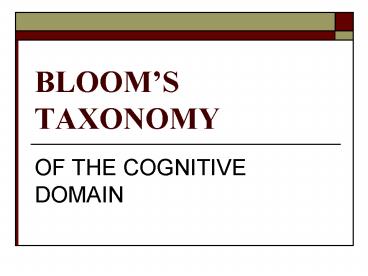BLOOM PowerPoint PPT Presentation
1 / 24
Title: BLOOM
1
BLOOMS TAXONOMY
- OF THE COGNITIVE DOMAIN
2
BLOOMS TAXONOMY
Competence Skills Demonstrated
Remembering The recall of specific information
Understanding Comprehension of what was read
Applying Converting abstract content to concrete situations
Analyzing Comparison and contrast of the content to personal experiences
Evaluating Judgment and evaluation of characters, actions, outcomes, etc., for personal reflection and understanding
Creating Invention, production of an original piece. YOU design it!
3
RememberingMemorization
- Observation and recall of information
- Knowledge of dates, events, places
- Knowledge of major ideas
- Mastery of subject matter
4
RememberingMemorization
- Arrange
- Define
- Describe
- Duplicate
- Identify
- Label
- List
- Memorize
- Name
- Order
- Quote
- Recall
- Recognize
- Relate
- Repeat
- Reproduce
5
Understanding COMPREHENSION
- Understand information
- Grasp meaning
- Translate knowledge into new content
- Interpret facts, compare, contrast
- Order, group, infer causes
- Predict consequences
6
Understanding COMPREHENSION
- Classify
- Describe
- Discuss
- Explain
- Express
- Identify
- Indicate
- Locate
- Recognize
- Report
- Restate
- Review
- Select
- Translate
7
Applying Using
- Use information
- Use methods, concepts, theories in new situations
- Solve problems using required skills or knowledge
8
Applying Using
- Apply
- Choose
- Demonstrate
- Dramatize
- Employ
- Illustrate
- Interpret
- Operate
- Practice
- Schedule
- Sketch
- Solve
- Use
- Write
9
Analyzing Taking apart
- Recognition of patterns
- Organization of parts
- Discovery of hidden meanings
- Identification of components
10
Analyzing Taking apart
- Analyze
- Appraise
- Calculate
- Categorize
- Compare
- Contrast
- Criticize
- Differentiate
- Discriminate
- Distinguish
- Examine
- Experiment
- Question
- Test
11
Evaluating Judging
- Compare and discriminate between ideas
- Assess value of theories, presentations
- Make choices based on reasoned argument
- Verify value of evidence
- Recognize subjectivity
12
Evaluating Judging
- Appraise
- Argue
- Assess
- Attach
- Choose
- Compare
- Defend
- Estimate
- Judge
- Predict
- Rate
- Select
- Support
- Value
- Evaluate
- Explain
13
Creating
- Assemble
- Construct
- Design
- Develop
- Formulate
- Write
14
REFERENCES
- Bloom, B., Englehart M., Furst, E., Hill, W.,
Krathwohl, D. (1956). Taxonomy of educational
objectives The classification of educational
goals. Handbook I Cognitive Domain. New York
Longmans Green.
15
Web resources
- http//www.che.wsu.edu/millerre/bloom.html
- http//www.coun.uvic.ca/learn/program/hndouts/bloo
m.html - http//www.kent.wednet.edu/KSD/MA/resources/blooms
/teachers_blooms.html - http//www.tecweb.org/eddevel/blooms.html
- http//www.valdosta.peachnet.edu/whuitt/psy702/co
gsys/critthnk.html
16
BLOOMS TAXONOMY
- applied to
- GOLDILOCKS AND THE THREE BEARS
17
Rememberingthe recall of specific information
- Who was Goldilocks?
- Where did she live? With whom?
- What did she do in the forest?
18
Understandingcomprehending of what was read
- This story is about ___________ (topic).
- This story tells us _________(main idea).
- What did Goldilocks look like?
19
Applyingthe converting of abstract content to
concrete situations
- How were the bears like real people?
- Why did Goldilocks go into the little house?
- Draw a picture of what the bears house looked
like. - Draw a map showing Goldilocks house, the path in
the forest, the bears house, etc.
20
Analyzingthe comparison and contrast of the
content to personal experience
- How did each bear react to what Goldilocks did?
- How would you react?
- Compare Goldilocks to any of your friends.
- Do you know any animals (pets) that act human?
21
EVALUATIONthe judgment and evaluation of
characters, actions, outcomes, etc., for personal
reflection and understanding
- Why were the bears angry with Goldilocks?
- Do you think Goldilocks was happy to get home?
Explain your answer. - Do you think she learned anything by going into
the bears house? Explain your answer. - Would you have gone into the bears house? Why
or why not?
22
EVALUATION CONT.
- Do parents have more experience and background
than their children? Give an example from your
own history. - Do you think this really happened to Goldilocks?
Why or why not? - Why would a grown-up write this story for
children to read? - Why has the story of Goldilocks been told to
children for many, many years?
23
Creating
- Make a diorama of the bears house and the
forest. - Make a puppet out of one of the characters.
Using the puppet, act out the story.
24
References
- http//www.ops.org/reading/blooms_taxonomy.html

